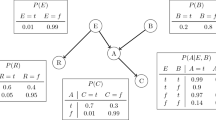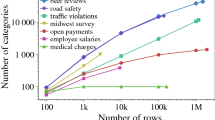Abstract
An important property of Context-Free Programmed Grammars (CFPG) is that some context-sensitive Languages can be generated by CFPG. To infer a special class of CFPG for syntactic pattern recognition is the motivation of this paper. First an one-dimensional string is transformed into a corresponding binary tree. Then in terms of the structure of subtrees, and the semantic rules corresponding to the context-free productions, a method for the inference of Context-free Programmed Grammar is presented. Inference of Stochastic Context-Free Programmed Grammar (STCFPG) by the maximum-likelihood estimate approach is also discussed.
Similar content being viewed by others
References
K. S. Fu,Syntactic Pattern Recognition and Applications (Prentice-Hall, New York, 1982).
T. Pavilidis,Structure Pattern Recognition (Springer-Verlag, New York, 1977).
A. V. Aho and J. D. Ullman,The Theory of Parsing, Translation and Compiling, Vol. 1 (Prentice-Hall, Parsing, 1972).
A. Solomaa,Formal Languages (Academic Press, New York/London, 1973).
K. S. Fu and T. L. Booth, “Grammatica Inference, Introduction and Survey,”IEEE Transactions on Systems, Man, and Cybernetics, Vol. SMC-5, No. 1 and No. 5 (1975).
D. Angulin, “Inductive Inference of Formal Languages from Positive Sample Data,”Information and Control 45: 117–135 (1980).
D. J. Rosenkrantz, “Programmed Grammars and Classes of Formal Languages,”JACM 16: 17–131 (1969).
D. E. Knuth, “Semantics of Context-free Languages,”Math. Syst. Theory 2: 127–146 (1968).
H. Bunke, “On the Generative Power of Sequential and Parallel Programmed Graph Grammar's” submitted for publication inComputing, (1980).
J. W. Tai, “Inference of a Class of Context-Free Programmed Grammars for Syntactic Pattern Recognition,”Proc. PRIP81, pp. 81–21 (Dallas, Texas, Aug. 2–5, 1981).
P. H. Swain and K. S. Fu, “Stochastic Programmed Grammars for Syntactic Pattern Recognition,”PATTERN RECOGNITION,4: 83–100 (1972).
K. S. Fu, “Stochastic Language for Picture Analysis,”Computer Graphics and Image Processing, Vol. 34 (December 1973).
J. J. Horning, “A Study of Grammatical Inference,” Ph.D. dissertation, Dept. Comput. Sci., Stanford Univ., Stanford, Calif. (1969).
A. R. Patel, “Grammatical Inference for Probabilistic Finite-State Languages,” Ph.D. dissertation, Dep. Elec. Eng. Compt. Sci. Conn. Stoors (1972).
Author information
Authors and Affiliations
Additional information
This work was supported in part by the NSF Grant ECS 78-16970.
Rights and permissions
About this article
Cite this article
Tai, J.W., Fu, K.S. Inference of a class of CFPG by means of semantic rules. International Journal of Computer and Information Sciences 11, 1–23 (1982). https://doi.org/10.1007/BF00993198
Received:
Revised:
Issue Date:
DOI: https://doi.org/10.1007/BF00993198




